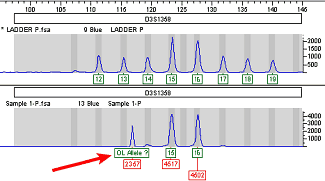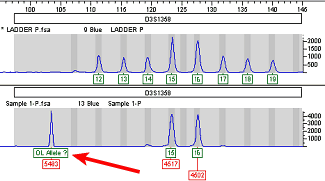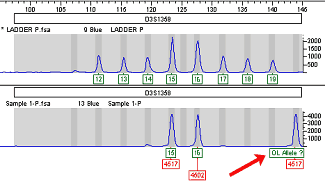Archival Notice
This is an archive page that is no longer being updated. It may contain outdated information and links may no longer function as originally intended.
Home | Glossary | Resources | Help | Contact Us | Course Map
Allelic ladders represent the most common alleles at each locus and were established through the evaluation of data from several hundred individuals. Alleles within the STR loci are known to vary greatly between individuals, and the kit ladders do not represent all possible types. Alleles that size outside allele categories represented in the ladder are often referred to as off ladder (OL) alleles.
In general, proprietary sizing software is designed to designate allele types if the allele size is within one of the allele categories defined by the ladder. The software designates an allele that falls outside of these allele categories as off ladder unless the manufacturer has established virtual allele categories. Virtual alleles are alleles that have been previously characterized, but are not present in the allelic ladder. For all defined virtual alleles, the software designates the allele type, rather than designating it as an off ladder allele.
It is not unusual in forensic autosomal STR testing to see microvariants.04 A microvariant represents an incomplete repeat for a given allele. For instance, at D18S51 a 15 allele designation means that there are 15 AGAA's along the fragment. However, a 14.2 allele designation means that there are 14 AGAA repeats along the fragment and an additional 2 bases: AG. Microvariants are reported as the number of complete repeat units and are designated as an integer (e.g., 14). Any partial repeat is designated as a decimal, followed by the number of bases in the partial repeat (e.g., ".2").
Many microvariants are represented in allelic ladders or have virtual allele categories within the software program; those that do not have established categories are designated as off ladder alleles.
While off ladder alleles have been well documented with forensic STR testing, some may not have been previously characterized. The National Institute of Standards and Technology (NIST) website has a listing of off ladder alleles and can be used as a reference in these instances. If it is determined that an allele has not been characterized, it may be advisable to rerun the sample to confirm the type.
The most common approach for reporting alleles that size higher or lower than the allelic ladder range is as follows:
- Alleles that are less than the lowest allele on the specific ladder are reported as "less than X."
- Alleles that are greater than the largest allele on the specific ladder are reported as "greater than X."
Additional Online Courses
- What Every First Responding Officer Should Know About DNA Evidence
- Collecting DNA Evidence at Property Crime Scenes
- DNA – A Prosecutor’s Practice Notebook
- Crime Scene and DNA Basics
- Laboratory Safety Programs
- DNA Amplification
- Population Genetics and Statistics
- Non-STR DNA Markers: SNPs, Y-STRs, LCN and mtDNA
- Firearms Examiner Training
- Forensic DNA Education for Law Enforcement Decisionmakers
- What Every Investigator and Evidence Technician Should Know About DNA Evidence
- Principles of Forensic DNA for Officers of the Court
- Law 101: Legal Guide for the Forensic Expert
- Laboratory Orientation and Testing of Body Fluids and Tissues
- DNA Extraction and Quantitation
- STR Data Analysis and Interpretation
- Communication Skills, Report Writing, and Courtroom Testimony
- Español for Law Enforcement
- Amplified DNA Product Separation for Forensic Analysts




